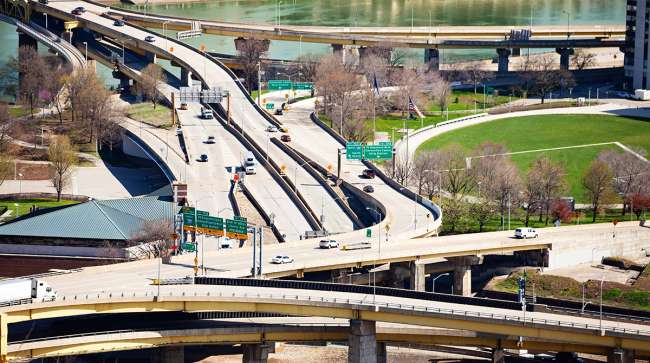Staff Reporter
Pennsylvania Trucking Industry Opposes State DOT’s Bridge Tolling Plan

[Stay on top of transportation news: Get TTNews in your inbox.]
The Pennsylvania Department of Transportation has released a list of bridges that are being considered for tolling, a practice the state’s trucking community has bristled against.
The agency on Feb. 18 released the list, which contains nine interstate bridge projects. The bridges are being considered as part of PennDOT’s Pathways Major Bridge Public-Private Partnership program. PennDOT’s Pathways initiative is meant to help the agency explore sustainable transportation financing options in response to an infrastructure-related funding gap.
The Pennsylvania Motor Truck Association expressed opposition to the tolls, which truckers (and other drivers) already encounter on the Pennsylvania Turnpike. PMTA President Rebecca Oyler, who began her role with the association Feb. 15, said the trucking industry already pays almost 40% of all taxes owed by Pennsylvania motorists despite covering only 9% of the total miles traveled.
Pennsylvania’s mobility needs have grown and with it, our funding needs have grown as well.
We are announcing the bridges being considered for the PennDOT Pathways Major Bridge Public-Private Partnership (P3) Initiative. Learn more at https://t.co/PtjlNg5scJ. pic.twitter.com/LOeQCFPq0q — PA Department of Transportation (@PennDOTNews) February 18, 2021
“In the pursuit of the safety of the motoring public, the Pennsylvania Motor Truck Association supports the rehabilitation or replacement of aging infrastructure, but cannot accept the invoice for it,” Oyler said. “We continue to pay our fair share. Our industry, along with every other business that relies on trucks to deliver their products in Pennsylvania, will suffer if PennDOT is permitted to move forward with its bridge tolling agenda.”
Specifically, the bridges that appear on PennDOT’s list represent nine counties and carry interstates 78, 79, 80, 81, 83 and 95. The agency picked bridges that are in various locations throughout the state to avoid impacting just one region. These bridges also were selected based on their need for timely attention and the feasibility of construction beginning in the next few years, according to PennDOT.
READ MORE: PennDOT Gets $407.2 Million for Road, Bridge Projects
One project the agency listed is the replacement of the John Harris Memorial (South) Bridge, which carries I-83 across the Susquehanna River, forming a link to Harrisburg. PMTA spokesman Brandon Moree noted the intersection of I-83 and state Route 581, located about a mile from the bridge and a component of Harrisburg’s Capital Beltway, ranks No. 98 on the American Transportation Research Institute’s top truck bottlenecks report, which was released in February 2020.
Another listed project would involve replacing bridges and widening the interchange that carries I-79 through Bridgeville, which is 15 miles southwest of Pittsburgh. Also listed is the project to replace the dual North Fork Bridges that carry I-80 in Brookville, which is 80 miles east of the Ohio border. PennDOT estimates the North Fork Bridges accommodate about 30,897 vehicles per day. Trucks represent approximately 44% of this traffic.
An early finding of PennDOT’s Planning and Environmental Linkages (PEL) study suggested tolling major bridges that are in need of replacement or rehabilitation may be a viable funding solution. PennDOT is conducting the PEL study to identify alternative funding solutions and establish a methodology for their evaluation.
The P3 model is designed to provide a steady source of revenue for these infrastructure improvements while boosting the vitality of the state’s economy and transportation network. According to PennDOT, 74% of highway and bridge funding is generated through gas taxes. However, fuel consumption has been decreasing, creating a negative effect on fuel tax revenue.
According to PennDOT, the department’s current highway and bridge maintenance budget of $6.9 billion per year is about half of the $15 billion needed to keep the state’s system in good repair.
“Our reliance on funding models from the last century leaves us especially vulnerable to fund losses stemming from volatile economic conditions and the increasing transition to alternative fuel or electric vehicles,” PennDOT Secretary Yassmin Gramian said. “This initiative will help us make much-needed improvements without compromising the routine projects our communities and industry partners rely on.”
Tolls would be electronic and would be collected through E-ZPass devices or license plate billing. Funds collected through the tolls would return to the bridge associated with the toll for maintenance, operation and construction needs.
PennDOT plans to issue a request for information from industry representatives the week of Feb. 22 to gather feedback. A request for qualifications is expected from the agency in the spring.
“We will certainly be involved with public comments,” Moree told Transport Topics.
Want more news? Listen to today's daily briefing below or go here for more info:
Distributed by Tribune Content Agency, LLC




